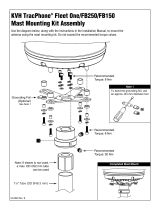
Table of Contents 4012 GX Installation Manual
ix
1. 4012 GX SYSTEM CONFIGURATION(S) ....................................................................................................................................... 1-1
1.1. SYSTEM CABLES ............................................................................................................................................................................................. 1-1
1.2. OTHER INPUTS TO THE SYSTEM .................................................................................................................................................................. 1-1
1.3. SIMPLIFIED BLOCK DIAGRAM OF A 4012 GX SYSTEM ........................................................................................................................... 1-1
1.4. DUAL ANTENNA CONFIGURATION ............................................................................................................................................................. 1-1
1.5. OPEN ANTENNA-MODEM INTERFACE PROTOCOL (OPENAMIP™) SPECIFICATION: ........................................................................ 1-2
1.5.1. Overview: ........................................................................................................................................................................................ 1-2
1.5.2. Interface requirements: ......................................................................................................................................................... 1-2
1.5.3. Utilized OpenAMIPTM Commands: ................................................................................................................................... 1-2
2. SITE SURVEY .................................................................................................................................................................................................. 2-1
2.1. SITE SELECTION ABOARD THE SHIP .......................................................................................................................................................... 2-1
2.2. ANTENNA SHADOWING (BLOCKAGE) AND RF INTERFERENCE .............................................................................................................. 2-1
2.3. MOUNTING FOUNDATION ........................................................................................................................................................................... 2-2
2.3.1. Mounting on Deck or Deckhouse ...................................................................................................................................... 2-2
2.3.2. ADE Mounting Considerations ........................................................................................................................................... 2-2
2.3.3. Sizing of the support pedestal ............................................................................................................................................ 2-2
2.4. MOUNTING HEIGHT ...................................................................................................................................................................................... 2-3
2.5. MAST CONFIGURATIONS ............................................................................................................................................................................. 2-3
2.5.1. Vertical Masts .............................................................................................................................................................................. 2-4
2.5.2. Raked Masts .................................................................................................................................................................................. 2-4
2.5.3. Girder Masts ................................................................................................................................................................................. 2-4
2.5.4. Truss Mast ..................................................................................................................................................................................... 2-5
2.6. SAFE ACCESS TO THE ADE .......................................................................................................................................................................... 2-5
2.7. BELOW DECKS EQUIPMENT LOCATION ..................................................................................................................................................... 2-5
2.8. CABLES ............................................................................................................................................................................................................. 2-5
2.8.1. ADE/BDE Coaxial Cables ........................................................................................................................................................ 2-6
2.8.2. Antenna Power Cable .............................................................................................................................................................. 2-6
2.8.3. Air Conditioner Power Cable ............................................................................................................................................... 2-6
2.8.4. ACU Power Cable/Outlet ........................................................................................................................................................ 2-6
2.8.5. Gyro Compass Cable ................................................................................................................................................................ 2-6
2.9. GROUNDING .................................................................................................................................................................................................... 2-7
3. INSTALLATION ............................................................................................................................................................................................. 3-1
3.1. UNPACKING AND INSPECTION .................................................................................................................................................................... 3-1
3.2. ASSEMBLY NOTES AND WARNINGS ........................................................................................................................................................... 3-1
3.3. INSTALLING THE ADE ................................................................................................................................................................................... 3-2
3.3.1. Prepare the 61” Radome Assembly .................................................................................................................................. 3-2
3.3.2. Installing the 61” Radome Assembly .............................................................................................................................. 3-3
3.4. GROUNDING THE PEDESTAL ......................................................................................................................................................................... 3-6
3.5. REMOVING THE SHIPPING/STOW RESTRAINTS PRIOR TO POWER-UP .............................................................................................. 3-7
3.5.1. Removing the AZ Shipping/Stow Restraint .................................................................................................................. 3-7
3.5.2. Removing the EL Shipping/Stow Restraint ................................................................................................................... 3-8
3.5.3. Removing the CL Shipping/Stow Restraint ................................................................................................................ 3-10
3.6. INSTALLING THE BELOW DECKS EQUIPMENT. ........................................................................................................................................ 3-11
3.6.1. General Cautions & Warnings .......................................................................................................................................... 3-11
3.7. CONNECTING THE BELOW DECKS EQUIPMENT ...................................................................................................................................... 3-11
3.7.1. Connecting the ADE AC Power Cable .......................................................................................................................... 3-11
3.7.2. Connecting the BDE AC Power Cables ........................................................................................................................ 3-11
3.7.3. Media Xchange Point™ (MXP) Connections ............................................................................................................. 3-11





























